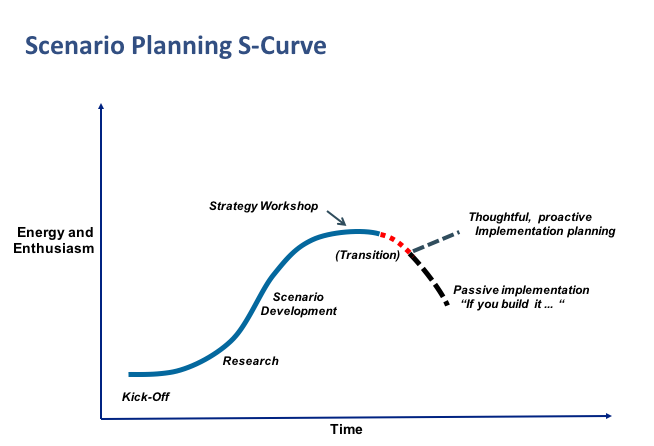A common criticism of conventional strategic-planning undertakings is that they run out of steam, and that the truly innovative ideas that come out of the process tend not to get implemented, despite initial energy and enthusiasm. Over the years in our own scenario consulting business, FSG has worked hard on capturing scenario planning value by keeping a tight focus on implementation. But we recognize that the challenge is real.
Implementation is critical to capturing scenario planning value – but it’s hard
There are many reasons why acting on big, important insights is hard. Sometimes moving out on even one big idea feels like too heavy a lift, especially with today’s insanely fast business tempo. Or the implied investment is too great at a time of budget-cutting and layoffs. Sometimes vested interests feel threatened and put up roadblocks. Or they co-opt the cool ideas and twist them into something quite different from the original intent of the strategic planners.
There are many other, firm-specific reasons for implementation failure.
One common pitfall – which we’ve heard reported by companies over and over in our scenario consulting world – is the tendency to assume that momentum will sustain the initial enthusiasm and energy coming out of a planning process. But it rarely works like that, once people are plucked back into their day jobs and have present-day (as opposed to futures) issues to worry about. What a Coast Guard client once called “the tyranny of the present” is indeed a formidable force.
This loss of strategic momentum is captured in the Scenario S Curve image below, in the context of the FSG scenario-planning process. A lot of scenario planning value comes from the strategy workshop, which is the most important step of the FSG scenario process, but there’s a natural tail-off in energy and enthusiasm after it’s over. Sometimes this is because there is no explicit plan to act on the strategy outputs, in which case the project report gets delivered to the senior owner of the effort, but with no explicit expectation that she or he will act on it. And once again, the tyranny of the present takes over. The lost momentum is hard to recover.

It’s FSG’s view that it is both important and possible to flatten the S curve – that is, to capture the full scenario planning value by maintaining focus and energy on the critical work of implementation, especially as the project team gets pulled back into normal work mode.
The trick is to actively plan the implementation phase well in advance – in the project scoping phase, really. That means budgeting time for the project team to remain at least partially engaged beyond the workshop. But more importantly it means building into the process some kind of decision milestone for senior leadership to evaluate strategic options identified in the workshop process. Here is where leadership must commit to making some decisions about which strategies the organization is prepared to invest in. This is where leadership asserts ownership over a manageable set of strategies it is prepared to champion. Relative to the amount of material coming out of the workshop, the number of strategies actually chosen may be modest. That’s fine; more scenario planning value is created when a firm acts on a small set of meaningful strategies than when a large set is embraced, for which the firm lacks the organizational or financial capacity to adopt. Lower priority strategies can always be revisited and acted upon later.
Even with a modest, manageable set of strategies to implement, the work of the project team is still not done. Implementation teams need to be formed. Subject matter experts need to be recruited to work out the details of implementation processes. Business plans need to be coordinated. Contingencies must be drafted, etc., etc.
So, clearly, there is substantial implementation work that gets underway after the strategy workshop. Without that commitment, implementation success will be elusive. It’s our view that even the most compelling, innovative strategies need deliberate and persistent attention, from both project team and senior leadership. If thoughtfully planned and coordinated, the post-workshop implementation activity need not be an undue burden on already busy staff. In fact, the implementation work tends to re-energize the process and greatly heighten the chances of strategic follow-through and ultimate success in the marketplace.
Note: Special thanks to Bob Etris of partner firm Evans Incorporated for sparking the initial thought behind this blog piece.

Regarding your curve, we have
Regarding your curve, we have discussed this phenomenon before. My thoughts are that someone versed in managing change should be involved starting with kick off. It can be — may have to be — someone from outside; a change management expert, maybe ACMP certified (www.acmpglobal.org). His or her function during the research phase is to tutor an inside change manager, one for whom CM is their full time job, not a collateral assignment. During the scenario development phase, the inside CM should be building a small team. That team should be fully engaged in the process and be prepared to carry the momentum of the strategy workshop into the earliest steps of the implementation process: building strong sponsorship and helping guide the team responsible for turning strategy into action. That includes developing the clear vision of the future state, the steps to get there, who is responsible for those steps, and how success will be measured and monitored.
By far the biggest contributor to successful change is top leadership commitment and engagement.
Of course this assumes that the client really wants to achieve a winning strategy — do something different. Some don’t. Not really. Some just want to validate their current approach.
Thanks, Steve. It’s always
Thanks, Steve. It’s always gratifying — and valuable! — to hear from former FSG clients on best practices around change. Your point about some leaders not really being committed to change is well-taken. Which makes one wonder why ambitious, time-consuming strategy projects get launched in the first place. Sometime it’s outside pressure (e.g., boards). Other times it’s in response to internal urging to reevaluate the current trajectory. Too often, however, there’s no corresponding commitment on leadership’s part to actually act on the strategy outcomes. Often it’s better not to undertake any strategic renewal process at all rather than do it halfheartedly or on the cheap. It’s a prescription for failure and furthermore it makes it all that much harder for future efforts to be taken seriously. You’ve provided some great, practical ideas about anticipating change obstacles — and investing in change resources up-front. Thanks!